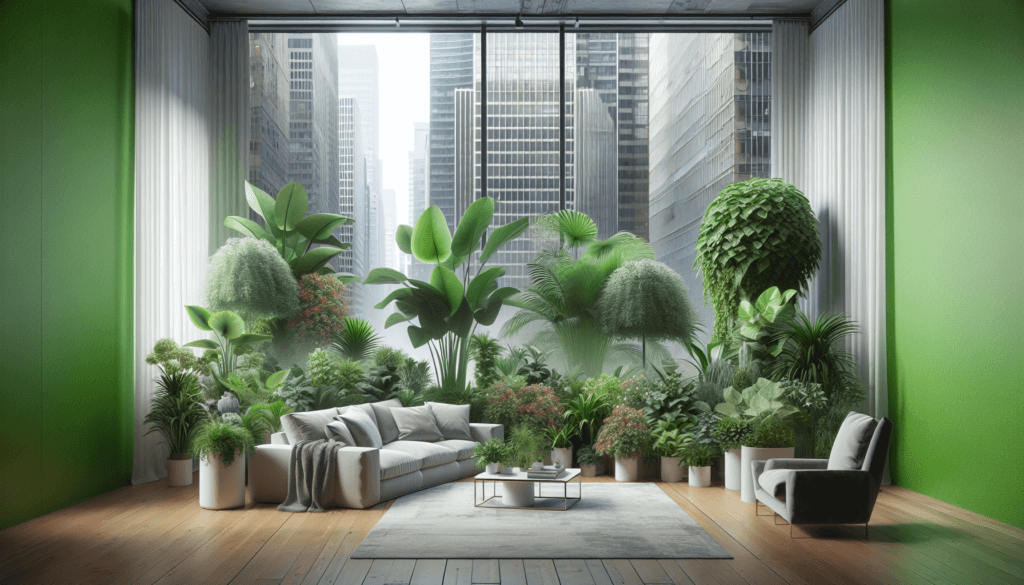Did you know that the air quality in urban spaces can often be worse than in outdoor environments? With pollution levels on the rise, it’s essential to find ways to purify the air in your home or office. Fortunately, nature has provided us with a natural solution – indoor plants. These green companions not only add beauty to our surroundings but also have the incredible ability to filter harmful toxins from the air. In this article, we will explore the top five indoor plants that are perfect for creating a cleaner and healthier atmosphere in urban spaces.
1. Peace Lily (Spathiphyllum sp.)
– Description and features
The Peace Lily, also known as Spathiphyllum, is a popular indoor plant known for its beautiful white flowers and glossy, dark green leaves. This plant is native to tropical regions and can grow up to 3 feet in height. It is a low-maintenance plant that thrives in low light conditions, making it perfect for indoor spaces.
– Air purifying abilities
One of the reasons why the Peace Lily is highly recommended for indoor spaces is its excellent air purifying capabilities. It is known to remove harmful toxins such as formaldehyde, benzene, and carbon monoxide from the air, making it a great choice for improving indoor air quality.
– Ideal growing conditions
To ensure the healthy growth of your Peace Lily, it is important to provide it with the ideal growing conditions. This plant prefers bright, indirect light but can also tolerate low light conditions. It thrives in moderate temperatures between 65-80°F (18-27°C). When it comes to watering, it’s important to keep the soil moist but not soggy. Overwatering can lead to root rot, so it’s best to allow the top inch of soil to dry out before watering again.
– Maintenance tips
Keeping your Peace Lily healthy and thriving is relatively easy. Regularly dust off the leaves to keep them clean and free from dust. Pruning is also important to maintain the plant’s shape and encourage new growth. If your Peace Lily starts to outgrow its current pot, you can repot it in a larger container with fresh potting soil. Remember to fertilize your Peace Lily every 6-8 weeks during the growing season to provide it with the necessary nutrients for healthy growth.

2. Snake Plant (Sansevieria trifasciata)
– Description and features
The Snake Plant, scientifically known as Sansevieria trifasciata, is a hardy and resilient indoor plant that requires minimal care. It has long, upright leaves with vibrant green color and unique patterns. What sets the Snake Plant apart is its ability to tolerate low light conditions and neglect, making it perfect for busy individuals or those with little experience in plant care.
– Air purifying abilities
Similar to the Peace Lily, the Snake Plant is also known for its air purifying abilities. It absorbs toxins such as formaldehyde, benzene, and xylene from the air, improving the air quality in your home or office space.
– Ideal growing conditions
The Snake Plant is versatile and can thrive in a wide range of growing conditions. It can tolerate both low light and bright, indirect light. It also tolerates a wide range of temperatures, making it suitable for different indoor environments. When it comes to watering, it’s important to let the soil dry out between waterings, as overwatering can lead to root rot.
– Maintenance tips
The low-maintenance nature of the Snake Plant makes it an ideal choice for those with busy lifestyles. It requires minimal attention and can go for long periods without water. It’s important to note that the leaves of the Snake Plant are prone to dust accumulation, so regular cleaning with a soft cloth or damp sponge is necessary to keep them looking fresh. Fertilize your Snake Plant once every 2-3 months during the growing season to encourage healthy growth.

3. Boston Fern (Nephrolepis exaltata)
– Description and features
The Boston Fern, scientifically known as Nephrolepis exaltata, is a popular choice for indoor plant enthusiasts due to its lacy, feathery fronds that add a touch of elegance to any space. This fern is native to tropical areas and requires high humidity to thrive.
– Air purifying abilities
Besides its aesthetic appeal, the Boston Fern is also known for its air purifying abilities. It effectively removes pollutants such as formaldehyde, xylene, and toluene from the air, improving the overall air quality in your home or office.
– Ideal growing conditions
To ensure the healthy growth of your Boston Fern, it is important to provide it with the ideal growing conditions. This fern thrives in bright, indirect light but can tolerate some shade. It requires high humidity, so regular misting or placing it on a tray filled with water and pebbles can help increase humidity around the plant. The ideal temperature for this fern ranges from 60-75°F (15-24°C).
– Maintenance tips
Keeping your Boston Fern healthy requires some specific care. As mentioned earlier, high humidity is crucial, so misting the fronds daily or placing the plant on a tray of water and pebbles can help maintain the necessary moisture levels. It’s also important to keep the soil consistently moist but not waterlogged. Avoid direct exposure to cold drafts or hot, dry air to prevent stress on the fern. Prune any yellow or damaged fronds regularly to maintain the overall appearance of the plant.

4. Spider Plant (Chlorophytum comosum)
– Description and features
The Spider Plant, scientifically known as Chlorophytum comosum, is a popular choice for indoor gardening due to its easy-care nature and attractive arching leaves. This plant features long, slender leaves with green and white stripes, resembling the appearance of a spider.
– Air purifying abilities
The Spider Plant is not only visually appealing but also known for its air purifying abilities. It removes harmful toxins such as formaldehyde, benzene, and carbon monoxide from the air, helping to improve indoor air quality.
– Ideal growing conditions
Spider Plants thrive in bright, indirect light but can tolerate some shade. They prefer temperatures between 55-75°F (13-24°C). When it comes to watering, it’s important to keep the soil evenly moist, allowing the top inch to dry out before watering again. Spider Plants also appreciate higher humidity, so misting the leaves or placing the plant near a humidifier can be beneficial.
– Maintenance tips
The Spider Plant is a relatively low-maintenance plant, making it suitable for beginners. It’s important to remove any browning or yellowing leaves regularly to maintain the plant’s appearance. Spider Plants are known for producing “spiderettes” or baby spider plants that can be propagated and grown into new plants. To propagate, simply detach the spiderettes from the mother plant and place them in water or moist soil to develop roots. Fertilize your Spider Plant once a month during the growing season to provide it with essential nutrients.

5. Aloe Vera (Aloe barbadensis)
– Description and features
The Aloe Vera plant, scientifically known as Aloe barbadensis, is a succulent that is highly popular for its medicinal properties. It features juicy, thick leaves arranged in a rosette, with serrated edges. Aloe Vera is not only visually appealing but also has numerous health benefits.
– Air purifying abilities
Aside from its well-known healing properties, Aloe Vera is also effective at purifying the air. It removes harmful pollutants such as formaldehyde and benzene, making it an excellent choice for improving the indoor air quality in your home or office.
– Ideal growing conditions
Aloe Vera thrives in bright, indirect light but can tolerate some direct sunlight. It prefers temperatures between 55-80°F (13-27°C) and enjoys being placed outdoors during the warm summer months. When it comes to watering, Aloe Vera is relatively drought tolerant and prefers to dry out between waterings. Overwatering can cause the roots to rot, so it’s important to allow the soil to completely dry out before watering again.
– Maintenance tips
Keeping your Aloe Vera plant thriving is relatively easy. Make sure to plant it in a well-draining potting mix to prevent waterlogged roots. Aloe Vera plants grow offsets or “pups” that can be separated and planted to form new plants. It’s important to repot your Aloe Vera every 2-3 years to provide it with fresh soil and space to grow. Fertilize your Aloe Vera plant sparingly, only during the growing season, using a balanced liquid fertilizer diluted to half strength.

Conclusion
Indoor plants not only add a touch of beauty and greenery to your living or working space but also provide numerous benefits, including air purification. The Peace Lily, Snake Plant, Boston Fern, Spider Plant, and Aloe Vera are all excellent choices when it comes to improving indoor air quality. Remember to provide them with the ideal growing conditions and follow the maintenance tips to keep them healthy and thriving. So go ahead, bring nature indoors and enjoy cleaner, fresher air for a healthier living environment.


